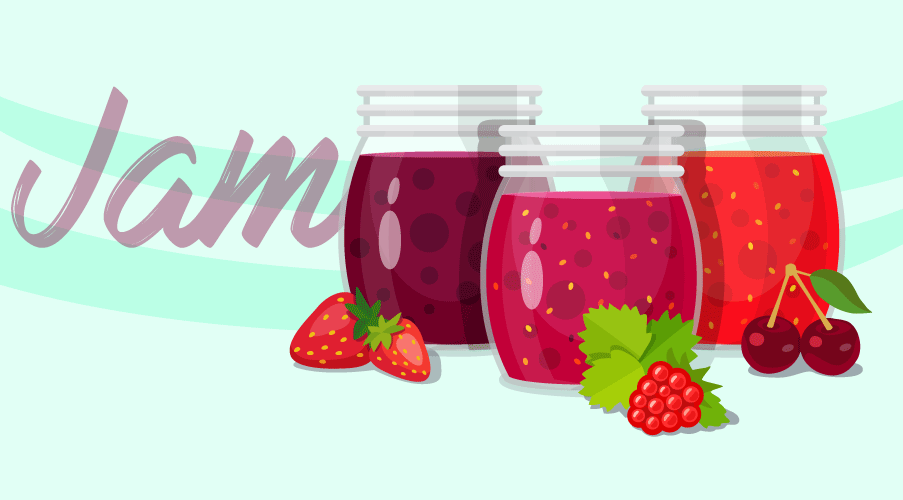We can prepare jam from any fruits with high sugar content. In the Industrial Jam production process, jam can be prepared from specific fruit or mix fruits (mixed fruit jam).
Jam is known as thick and gel-like consistency and made from fruit pulp, juice, or a blend of both. Which consist of sugar, pectin, and acid. Standards for jam preparation includes its fruit percentage, sugar content, and acidity. Jam should consist of around 45% fruit with sugar content not less than 68% and acid around 5g (citric acid). Jam preparation is one of the traditional processes of preservation.
Standards in Jam production process
FSSAI Jam standards
- Fruit-45%
- Total soluble solids (TSS) -65%
- Acid- 5g
- Preservatives- 40 ppm of SO2
FAO Jam standards
- Fruit Content-45%
- Total soluble solids (TSS) -60 to 65% or greater.
- Acid- 5g
- Preservatives- 40 ppm of SO2
FAO Jam Processing – [PDF]
Jam Production process-
1.Preparation of ingredients
Fruits-Take fresh fruit, peel and cut into small pieces and crush to make pulp or juice. Filter it if required.
Sugar Syrup– Sugar syrup is prepared by using cane sugar which is granulated, refined, and white. Dissolve it with water and then filter with muslin cloth before adding into pulp.
%sugar=(weight of sugar)/(weight of sugar+weight of water)×100
Pectin– All fruits contains pectin, external pectin is added as per the required strength of jam. Pectin powder is mixed with hot water to form gel. where pectin is added while mixing with hot water to prevent clump formation.
2. Cooking process
Cook the pulp to its boiling, add sugar or sugar syrup, and let the mixture boil with continuously stirring up to temperature 105oC. When boiled add pectin and acid to the boiling mixture up to required brix. We have to check whether jam prepared is following the required standards while finalizing the jam. the Check the consistency by using the sheet method.
3. Packaging of Jam
Fill the hot prepared jam in sterilized containers. allow to cool and close with sterilized lid. Store at a cool place.
Determination of endpoint of a Jam
1. Using a hand refractometer
2.Sheet test: In the boiling jam mixture, dip a cool metal(preferably) or wooden spoon and take the spoon out of the steam so that the syrup runs offside. At the initial boiling first, the drops are syrupy and light. As the mixture keeps boiling, the drops will get heavier and drop the spoon two at a time(two drops). Consider the final point is reached when the two drops form a sheet.

Defects in Jam Production Process and Prevention
Defect: Formation of Crystals
| Causes | Prevention |
| Excess Sugar | Use a tested recipe and measure ingredients accurately |
| Undissolved sugar sticking to sides of saucepot | Dissolve all sugar as jelly cooks. If necessary, scrap side of pan free of sugar crystals while cooking jelly |
| Mixture cooked too slowly or too long | Mixture cooked too slowly or too long |
Defect: Cloudiness
| Causes | Prevention |
| Jelly or jam allowed to stand before it was poured into jars or poured too slowly | Pour into jars immediately upon reaching jelling point. Work quickly. |
Defect: Development of Mold and fermentation In Jam
| Causes | Prevention |
| Yeasts and mold on jelly | Process in a boiling water canner. Test seal before storing. Pre-sterilize jars when processed less than 10 minutes in boiling water. |
| Imperfect sealing (common with paraffin covered jellies) | Use new flat lids for each jar and make sure there are no flaws. Pretreat lids per manufacturer’s directions. Use ring bands in good condition – no rust, no dents, no bends. Before applying lids, wipe sealing surface of jar clean. |
| Improper storage | Store processed jars in a dark, dry, cool place. Refrigerate after opening. |
Developed Jam is Too stiff or tough
| Causes | Prevention |
| Overcooking | Cook jelly mixture to a temperature of 8°F higher than the boiling point of water or until it “sheets” from a spoon. |
| Too much pectin in fruit | Use ripe fruit. Decrease amount of commercial pectin. |
| Too little sugar which requires excessive cooking | When pectin is not added, try 3/4 cup sugar to 1 cup juice for most fruits. |
Syneresis or “weeping” in Jam
| Causes | Prevention |
| Excess acid in juice makes pectin unstable | maintain proper acidity of juice. |
| Storage place too warm or storage temperature fluctuated | Store processed jars in a cool, dark, and dry place. Refrigerate after opening. |



